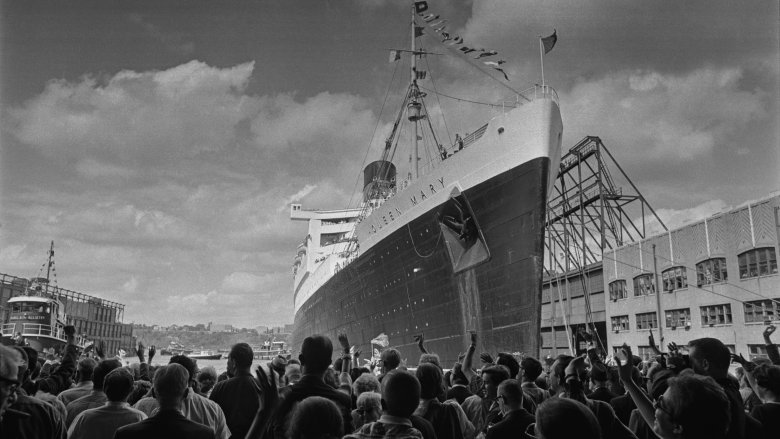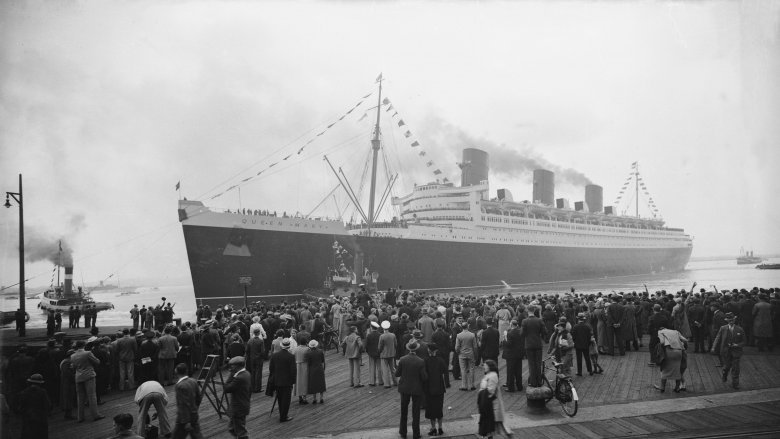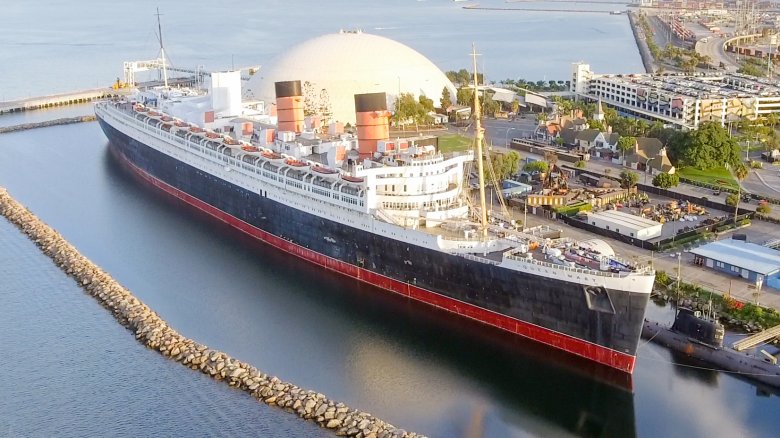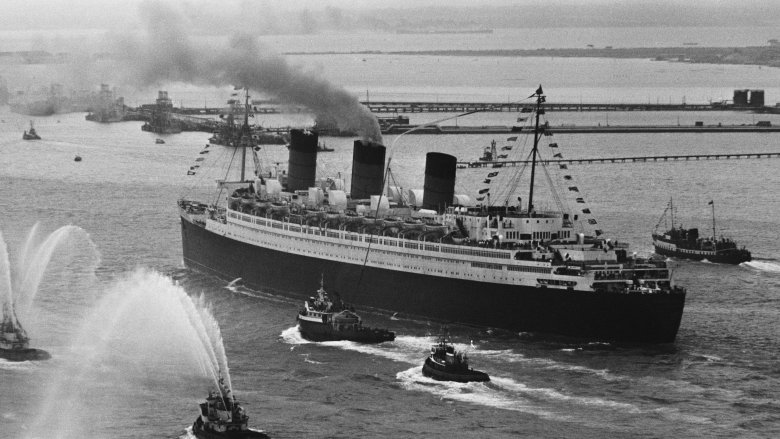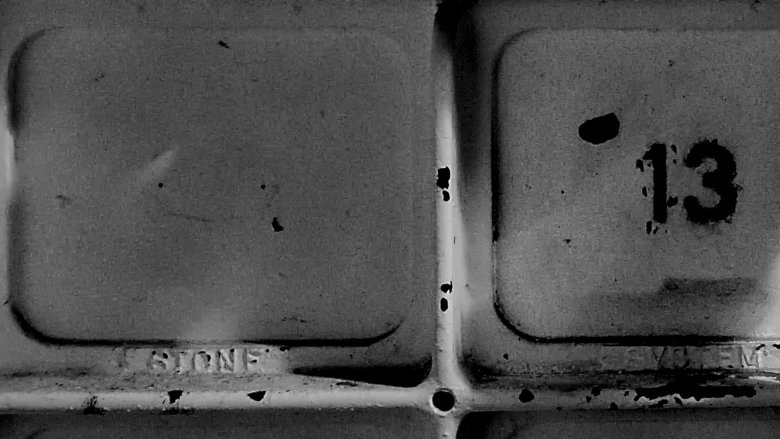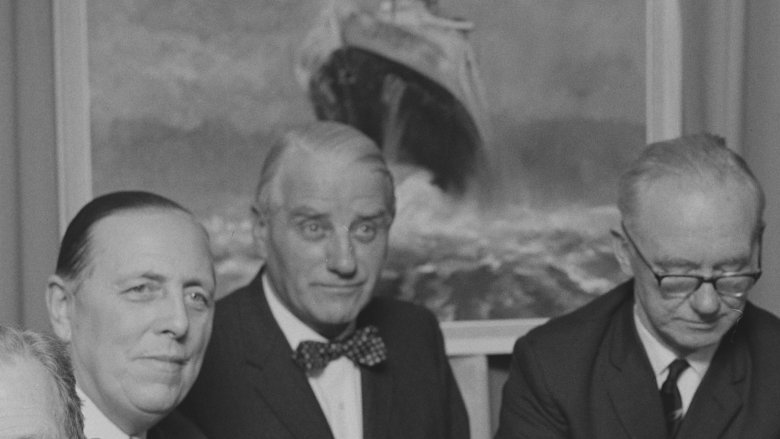Reasons People Think The Queen Mary Is Haunted
Everybody loves a good ghost story, but do you know what they love even more? A ghost story with some historical elements. Toss in a suitably creepy, kooky, and/or altogether ooky locale, and your haunted encounter somehow holds more weight than, say, your fresh-out-of-rehab cousin's ghost photography stories that you just have to nod at supportively because, you know, he's trying.
It's the whole reason you don't see a lot of horror movies that take place in a Chili's. Tales of the supernatural just have more pull when they take place in a freaky old mansion or a swamp full of bodies — places you look at, shiver, and think, "There's a story there."
And that's definitely the case with the Queen Mary. Repeatedly called one of the "most haunted places in the world," this ocean liner is practically custom made for campfire tales. Why do people see her and immediately assume she's home to some form of monster mash (and, by extension, various levels of the graveyard smash)? Here are reasons people think the Queen Mary is haunted.
The Queen Mary has a grim history
Ocean liners don't get much attention in this century unless they run into legal trouble or the toilets stop working, but back in the day, they were a symbol — a signal of prosperity, ingenuity, and the triumph of the human spirit over the forces of nature. They didn't have as many water slides as newer cruise ships, but this was generations ago and people were still learning what was important.
Massive amounts of work went into the creation of the RMS Queen Mary. All told, it took nearly four years to complete construction, and Shipping Wonders of the World says a river had to be widened just so that she could launch in September of 1934. If that date seems uncomfortably close to World War II to you, then good eye, soldier. The floating behemoth only had a few years of service as an ocean liner before she wound up conscripted into military service.
She spent the bulk of the war transporting troops and had her interior painted a uniform Navy grey, landing her the nickname "The Grey Ghost" (the less popular nickname "Bigboat Foreshadowsmith" never caught on). She was big, fast, and difficult to track, making her the perfect way to get soldiers from point A to point B. The Queen Mary undoubtedly bore witness to some of the horrors of battle, but this chapter does have a happy ending — she was used to carry troops home at the end of the war, too.
The Queen Mary has had a restless retirement
Post war, the Queen Mary saw plenty of love. She was refitted, repainted, and made fancier than ever. For the next several years, she was the most high-class way to cross the Atlantic Ocean.
But the good times can't last forever, and by the time the 1960s rolled around, there weren't a lot of people left who were interested in taking a frigid three day trip across the ocean when one of them newfangled airplanes could do the trick in half a jiffy and throw in free peanuts to boot. The ship made her final journey in 1967, and was permanently moored in Long Beach, California, as a floating hotel, museum, and tourist destination, which opened in 1971.
Strange though it may sound, the marketing pitch of "come check out our boat that doesn't go anywhere" didn't seem to pan out for any of the Queen Mary's owners over the next few decades. According to the New York Times, she was bounced from one proprietor to another, even spending some time as part of Disney's planned "Port Disney" theme park back before they figured out that superheroes have a better profit/loss ratio than retired ocean liners. We only bring this up because nothing is scarier than financial insolvency. Alright, on to the dead people.
The Queen Mary's collision with death
People die. It's one of the things that we're best at. Put enough of us in an area for long enough and eventually, a few of us are going to shuffle loose from our mortal coils. With that in mind, the Queen Mary had held millions of passengers by the time she was retired, and yes, things occasionally got crunchy. We'll start with the big one.
As we mentioned earlier, the Queen Mary was used as a transport ship during World War II, and was prized for her ability to move quickly and quietly. However, all large watercraft employed during the war were expected to use a "zig zag" formation: a serpentine movement designed to befuddle and perplex enemy submarines which might be waiting beneath the surface of the water to torpedo the living bejeezus out of them.
IWM reports it was during one such maneuver that the Queen Mary zigged straight into another ship, the HMS Curacoa, a British light cruiser. The collision chopped the Curacoa clean in half, killing all but a fraction of the more than 400 men on board. It wouldn't be the ship's last brush with tragedy.
Weird accidents onboard the Queen Mary
In 1966, 18-year-old crewman (or possibly fireman, according to Haunted Honeymoon; the accounts vary, and that's something you'll see a lot of here) John Pedder was taking part in a routine drill aboard the Queen Mary when he was abruptly and permanently squished by the number 13 bulkhead door. What happened next was of little shock to anyone: he died. What allegedly happened after that was somewhat more puzzling.
Over the next several years, Pedder was reportedly seen going about his spectral business just outside of Door 13. The reports come from security personnel and (here's where you're allowed to release a few lungfuls of skepticism in an exasperated sigh) publicists for the ship's "Ghosts and Legends" tours, the latter of whom swear that the experience was definitely worth $17.50 for adults and $14 for seniors. And that was in George H. W. Bush 1991 dollars, so you know they meant business.
A smoky apparition
Another alleged supernatural whatnot aboard the Gray Ghost is, in theory, the spiritual activity of Captain John Treasure Jones, a man so nautical that "Treasure" was his actual middle name. Jones was the captain of the Queen Mary from September of 1965 until her retirement in 1967. There are rumors that he still haunts her decks. What sort of uncanny evidence fuels these rumblings? Captain Jones smoked cigars, and people sometimes claim to smell cigar smoke on board. Breathtaking.
Now, ignoring for a moment that, according to Queen Mary Shadows, these reports were made by a professional psychic whose mustache and eyebrows appear to be haunted by the ghost of a vengeful Just For Men box and that they include all the specificity of a horoscope made of words cut from fortune cookies, they also exclude some important facts. For example, Captain Jones died quietly of an aneurysm a quarter of a century after the ship was permanently docked, and he'd worked much longer assignments on other ships. But who are we to question how the incorporeal choose their digs? The real problem with this story seems to be that it hinges on the argument "cigar smell = ghost" rather than the more structurally sound "cigar smell = a smell that lingers," but then again, it probably doesn't matter how sharp Occam's Razor is in a fight against the intangible.
Spooky shapes
One of the ship's more well-known hauntings comes courtesy of a little girl who drowned in the ship's pool. It's said that her name was Jackie, and beyond that, the details get murky. No one can agree on how old Jackie was when she died, which is sort of a red flag, but the gray areas of the story don't stop there.
According to Queen Mary Shadows, sometimes it was two girls that drowned, sometimes it's just the one. Sometimes they died in the second class pool, sometimes they died on a Treat Yourself day in first class. Sometimes the girl or girls died at the hands of a murderer. The point is, it's a veritable choose-your-own-adventure of paranormality.
In any case, Ghost Adventures did an episode where the titular adventurers caught a blurry image in the vague shape of a person while they stumbled around in the dark shouting "Jackie!" so, big props to Zak Bagans for everything he does.
